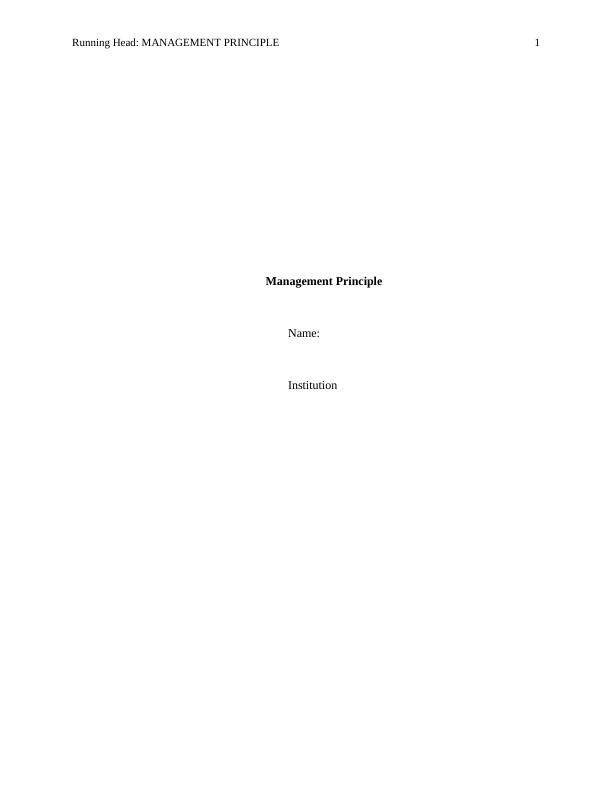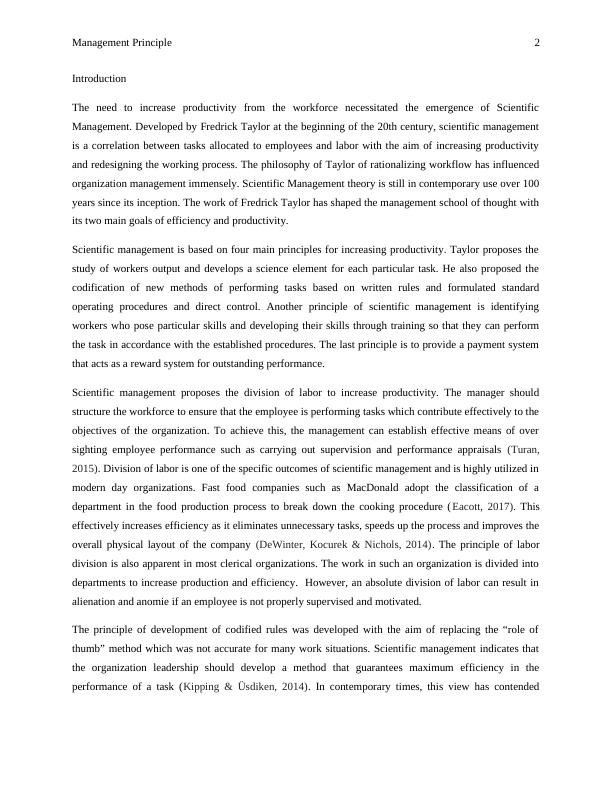Management Principle
Added on 2023-01-16
5 Pages1634 Words53 Views
Running Head: MANAGEMENT PRINCIPLE 1
Management Principle
Name:
Institution
Management Principle
Name:
Institution

Management Principle 2
Introduction
The need to increase productivity from the workforce necessitated the emergence of Scientific
Management. Developed by Fredrick Taylor at the beginning of the 20th century, scientific management
is a correlation between tasks allocated to employees and labor with the aim of increasing productivity
and redesigning the working process. The philosophy of Taylor of rationalizing workflow has influenced
organization management immensely. Scientific Management theory is still in contemporary use over 100
years since its inception. The work of Fredrick Taylor has shaped the management school of thought with
its two main goals of efficiency and productivity.
Scientific management is based on four main principles for increasing productivity. Taylor proposes the
study of workers output and develops a science element for each particular task. He also proposed the
codification of new methods of performing tasks based on written rules and formulated standard
operating procedures and direct control. Another principle of scientific management is identifying
workers who pose particular skills and developing their skills through training so that they can perform
the task in accordance with the established procedures. The last principle is to provide a payment system
that acts as a reward system for outstanding performance.
Scientific management proposes the division of labor to increase productivity. The manager should
structure the workforce to ensure that the employee is performing tasks which contribute effectively to the
objectives of the organization. To achieve this, the management can establish effective means of over
sighting employee performance such as carrying out supervision and performance appraisals (Turan,
2015). Division of labor is one of the specific outcomes of scientific management and is highly utilized in
modern day organizations. Fast food companies such as MacDonald adopt the classification of a
department in the food production process to break down the cooking procedure ( Eacott, 2017). This
effectively increases efficiency as it eliminates unnecessary tasks, speeds up the process and improves the
overall physical layout of the company (DeWinter, Kocurek & Nichols, 2014). The principle of labor
division is also apparent in most clerical organizations. The work in such an organization is divided into
departments to increase production and efficiency. However, an absolute division of labor can result in
alienation and anomie if an employee is not properly supervised and motivated.
The principle of development of codified rules was developed with the aim of replacing the “role of
thumb” method which was not accurate for many work situations. Scientific management indicates that
the organization leadership should develop a method that guarantees maximum efficiency in the
performance of a task (Kipping & Üsdiken, 2014). In contemporary times, this view has contended
Introduction
The need to increase productivity from the workforce necessitated the emergence of Scientific
Management. Developed by Fredrick Taylor at the beginning of the 20th century, scientific management
is a correlation between tasks allocated to employees and labor with the aim of increasing productivity
and redesigning the working process. The philosophy of Taylor of rationalizing workflow has influenced
organization management immensely. Scientific Management theory is still in contemporary use over 100
years since its inception. The work of Fredrick Taylor has shaped the management school of thought with
its two main goals of efficiency and productivity.
Scientific management is based on four main principles for increasing productivity. Taylor proposes the
study of workers output and develops a science element for each particular task. He also proposed the
codification of new methods of performing tasks based on written rules and formulated standard
operating procedures and direct control. Another principle of scientific management is identifying
workers who pose particular skills and developing their skills through training so that they can perform
the task in accordance with the established procedures. The last principle is to provide a payment system
that acts as a reward system for outstanding performance.
Scientific management proposes the division of labor to increase productivity. The manager should
structure the workforce to ensure that the employee is performing tasks which contribute effectively to the
objectives of the organization. To achieve this, the management can establish effective means of over
sighting employee performance such as carrying out supervision and performance appraisals (Turan,
2015). Division of labor is one of the specific outcomes of scientific management and is highly utilized in
modern day organizations. Fast food companies such as MacDonald adopt the classification of a
department in the food production process to break down the cooking procedure ( Eacott, 2017). This
effectively increases efficiency as it eliminates unnecessary tasks, speeds up the process and improves the
overall physical layout of the company (DeWinter, Kocurek & Nichols, 2014). The principle of labor
division is also apparent in most clerical organizations. The work in such an organization is divided into
departments to increase production and efficiency. However, an absolute division of labor can result in
alienation and anomie if an employee is not properly supervised and motivated.
The principle of development of codified rules was developed with the aim of replacing the “role of
thumb” method which was not accurate for many work situations. Scientific management indicates that
the organization leadership should develop a method that guarantees maximum efficiency in the
performance of a task (Kipping & Üsdiken, 2014). In contemporary times, this view has contended

End of preview
Want to access all the pages? Upload your documents or become a member.
Related Documents
Report on Concepts of the Strategic Managementlg...
|10
|2402
|74
Management of Organisations as a Sciencelg...
|14
|4159
|135
Foundation Management 9lg...
|9
|2203
|263
Scientific Theory of Managementlg...
|6
|1809
|39
Fredrick Taylor Management Theorylg...
|10
|715
|19
Organizational Theory: Classical and Neo-classical Approachlg...
|12
|2503
|48
